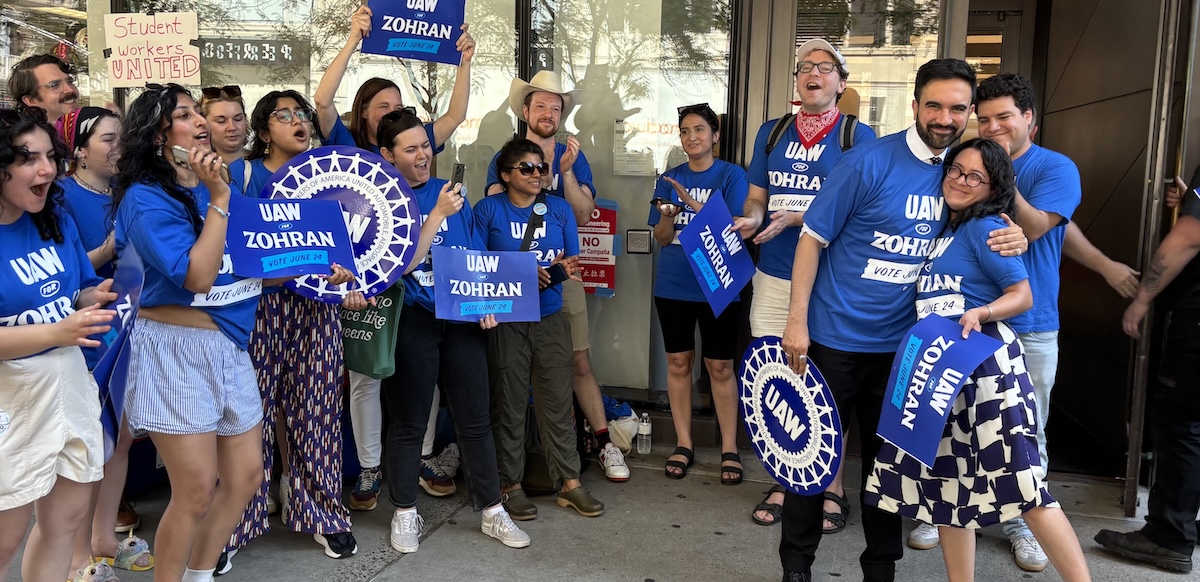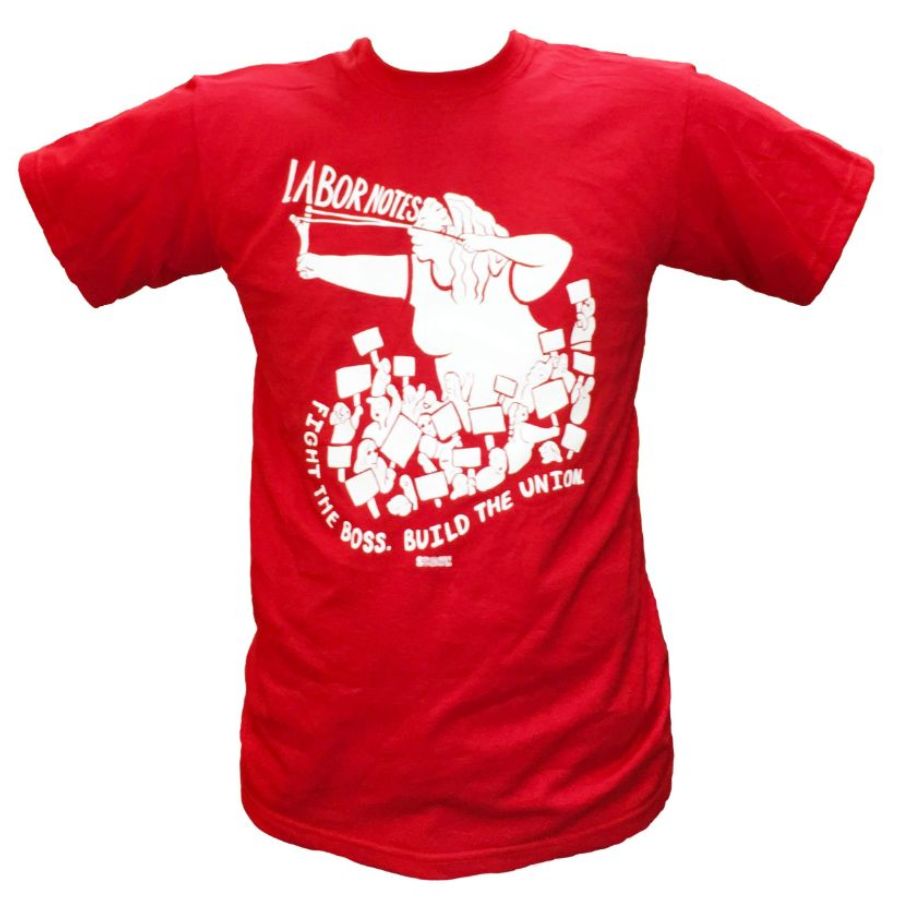Why the UAW Endorsed Zohran When Other New York City Unions Held Back

The Auto Workers endorsement of new York City mayoral candidate Zohran Mamdani was an important early boost to his winning primary campaign. It came about through the union’s more transparent and democratic candidate selection process, which broke out of the previous practice of backing the expected winner to curry favor or avoid punishment. Photo: UAW Region 9A.
Zohran Mamdani’s shock victory in this year’s New York City Democratic mayoral primary upended New York politics and called into question the effectiveness of big local unions, which mostly lined up behind loser Andrew Cuomo.
But labor was far from unified behind Cuomo: some unions opposed him, and one major union, the United Auto Workers, was the first to endorse Mamdani last fall.
This endorsement came at a time when Mamdani was a relatively unknown state legislator. It was the result of rank and file activism and a new culture of openness, transparency, and progressivism in the UAW.
As a result, the UAW helped power Mamdani’s victory and now stands poised to benefit from a new era of progressive New York City politics.
UNION TRANSFORMED
The UAW’s risky endorsement of Mamdani would never have happened without the transformation of the union that occurred over the past half-decade. After a serious of corruption and embezzlement scandals led to the removal and conviction of top UAW officials, the union reached a settlement with the U.S. Department of Justice that required a national referendum on adopting direct election of union leadership.
In 2021, UAW members voted overwhelmingly to adopt direct elections, a longtime goal for reformers. In the first-ever direct elections that followed, reformers won every race they ran in, including the UAW presidency and the leadership of Region 9A, which covers locals in the New York City area, New England and Puerto Rico.
As a result, the UAW’s endorsement process for the 2025 New York City elections was newly member-driven and transparent.
NEWLY OPEN PROCESS
Region 9A’s New York City Area CAP Council, the representative body of local presidents and at-large members that makes endorsement decisions, was focused last fall on defeating the scandal-plagued incumbent mayor, Eric Adams, and on pushing other candidates to work together to beat him. This plan used the opportunity created by the primary’s ranked-choice voting system.
The CAP Council opened its endorsement process to mayoral candidates and hosted a series of online forums with the four candidates who filled out union’s questionnaire: State Senators Zellnor Myrie and Jessica Ramos, City Comptroller Brad Lander, and Mamdani.
The forums were open to all UAW members, and the CAP Council asked local leaders to spread the word and solicit questions from the rank and file.
Over the course of two nights in November, candidates introduced themselves and were interviewed by a panel of regional leadership and leaders of four locals representing different industries within Region 9A: nonprofit/cultural institutions, legal services, academic workers, and manufacturing. Afterward, members could view recordings of the forums and fill out surveys with their impressions of the candidates.
All of this process was new: in the past, the CAP Council made endorsement decisions with little input from other members, who were mostly unaware of the council’s existence or role.

SUPPORT LABOR NOTES
BECOME A MONTHLY DONOR
Give $10 a month or more and get our "Fight the Boss, Build the Union" T-shirt.
This more open process provided an opening for the candidate with the most enthusiastic supporters to win an unlikely endorsement. Lander and Ramos had clear appeal to the UAW: Lander as a citywide elected official with a pro-union record, and Ramos as the powerful chair of the state senate labor committee. An October 2024 poll released by the New York Times showed Lander in fifth place, behind Adams, Cuomo, and two politicians who didn’t end up running. Mamdani, then in his second term as a state assembly member from Queens, had just announced his longshot campaign and was not included in the poll.
But Mamdani had just won the endorsement of the New York City chapter of the Democratic Socialists of America (DSA), his political home and the group that had helped him defeat an incumbent Democrat for his assembly seat in 2020. The chapter has built substantial electoral capacity since 2018, and has 10 elected officials in state and city offices.
Thousands of DSA members built the Mamdani campaign from scratch by donating, volunteering, posting on social media, and organizing within their unions and communities. Small-dollar donations helped power Mamdani’s long-shot campaign thanks to New York City’s public campaign funding system: mayoral candidates are eligible for an 8 to 1 public funds match for small donors if they limit spending to about $8 million in the primary and another $8 million in the general election.
ENTHUSIASTIC CORE
An enthusiastic core within the UAW, made up of DSA members and others excited about Mamdani’s economic populist platform, worked to bring the union and the candidate together. Although Mamdani lacked name recognition, he had shown up for striking UAW members in legal services and on university campuses over the preceding years.
Members helped drive turnout for the candidate town halls, and briefed Mamdani on the union’s issues. They encouraged likeminded colleagues to fill out feedback forms.
When the New York City Area CAP Council convened to vote on an endorsement in December, the meeting had unusually large rank-and-file attendance, but in the end there was little drama. The questionnaire responses overwhelmingly favored Mamdani, and most voting members had felt the excitement from their locals’ rank and file.
Although a couple of CAP Council members made critical remarks about Mamdani’s inexperience or electability, the council voted unanimously to endorse Mamdani, Lander, and Ramos, and to recommend voting against incumbent Adams.
The endorsement was a break from the union’s risk-averse past: in 2018, the UAW had actually endorsed Cuomo, at the time a powerful incumbent, in the gubernatorial primary against progressive challenger Cynthia Nixon.
RANKED-CHOICE SYSTEM
New York City uses ranked-choice voting in primaries for local offices, allowing voters to rank their top 5 choices for offices like mayor, but the CAP Council chose an unranked co-endorsement, leaving open the possibility of voting to rank the candidates later on in the race. At the time, few of the council members may have believed Mamdani had much chance of winning, but it made sense to harness the rank and file enthusiasm and hopefully corral the three candidates into a united anti-Adams, anti-Cuomo front.
The UAW’s mayoral endorsement came early, as many other unions chose to wait and see how Adams’s federal indictment would play out, and whether Cuomo would enter the race. Even before he announced his candidacy in March, Cuomo, a former governor who resigned in disgrace in 2021, led all the polls, and he soon racked up endorsements from the building trades and powerful unions like SEIU 32BJ and 1199SEIU United Healthcare Workers East. These large unions historically tend to endorse incumbents and front-runners in the hope of building relationships and avoiding retaliation.
No other unions endorsed Mamdani until April, and most unions that did endorse, like AFSCME District Council 37 and UNITE HERE Local 100, told members to rank him second or third on their ballots.
UAW CANVASSES
The UAW threw its weight into Mamdani’s powerful canvassing operation, hosting a kickoff event in the Bronx May 10 that drew 65 members, and held numerous other canvasses in the month leading up to the June 24 primary. These canvasses proved so popular among members—who signed up for over 1,000 volunteer shifts in total—that the union had to reprint its “UAW for Zohran” T-shirts four times.
In late May, as the race began narrowing to Cuomo and Mamdani, the CAP Council voted unanimously to rank Mamdani first, and UAW leaders from across New York State held a press conference to highlight Cuomo’s failures to stand with union members as governor.
The CAP Council’s project of creating a progressive slate largely succeeded: when one of its three candidates, Ramos, urged her voters to rank Cuomo second, within hours the Council voted to un-endorse her. Our other two endorsed candidates, Lander and Mamdani, ended up cross-endorsing each other, delivering Mamdani a crucial boost in the last days of the race.
UAW President Shawn Fain recorded a video endorsing Mamdani and attacking Cuomo, and the union put out ads with rank-and-file members explaining why they support Mamdani. On election day, Mamdani stopped by a UAW volunteer site and thanked the union for being the first to back his campaign.
After Mamdani’s big victory in the primary, he’s gathered endorsements from previously neutral unions like the United Federation of Teachers, as well as former Cuomo endorsers like SEIU 1199 and 32BJ (also SEIU), along with the NYC Central Labor Council.
The UAW remains one of his strongest supporters heading into the general election, where Adams and Cuomo are running on independent ballot lines. Its initially risky endorsement would never have happened without an organized and energized movement among the rank and file, as well as leadership willing to listen and be led. It’s no coincidence that one of New York City’s most small-d democratic major unions was also the first to endorse the surprise winner.
Sam Feldman is a member of the Executive Board of UAW Local 2325 and, since December 2024, an at-large member of the UAW Region 9A New York City Area CAP Council, and a member of DSA.

![Eight people hold printed signs, many in the yellow/purple SEIU style: "AB 715 = genocide censorship." "Fight back my ass!" "Opposed AB 715: CFA, CFT, ACLU, CTA, CNA... [but not] SEIU." "SEIU CA: Selective + politically safe. Fight back!" "You can't be neutral on a moving train." "When we fight we win! When we're neutral we lose!" Big white signs with black & red letters: "AB 715 censors education on Palestine." "What's next? Censoring education on: Slavery, Queer/Ethnic Studies, Japanese Internment?"](https://www.labornotes.org/sites/default/files/styles/related_crop/public/main/blogposts/image%20%2818%29.png?itok=rd_RfGjf)


